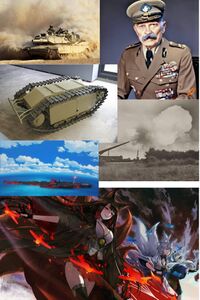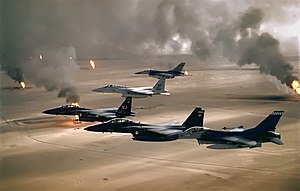The Great War
| The Great Trials (First Great Trial, Second Great Trial, The Final Trial) | |||||||||
|---|---|---|---|---|---|---|---|---|---|
 Clockwise from top left: Dutch Soldiers moving on top of a Azurnailian A-19 Heavy tank in the battle of Nubia, March 2014 - Portriat of Franz Nafida, Perishani Fascist, 2016 - Railcannon "Shiratsuyu" firing an Antimatter round on the abandoned city of Neu Swabia, March 2018 - Sakura Task Force I. - AZL Orochi en route towards Perishna, 2024 - Scimfaxi type Nuclear Suicide bomb, preserved at the National Museum of the Great Trials, September 2024 | |||||||||
| |||||||||
| Belligerents | |||||||||
| CAF(Azurnailia, Daphomir, Dutch Socialist States, Federation Of Perishna(Socialists) | Fascististan | Sunerstan | Most Serene republic of Perishna(Fascists) | ||||||
| Commanders and leaders | |||||||||
| CAF United Forces | UASF | Unknown, unorganized Resistance | Military Of Perishna | ||||||
| Units involved | |||||||||
| About 143 million | 7,830,930 | 16,890,380 | 484,398,000 | ||||||
| Casualties and losses | |||||||||
|
Civilian dead: 48,000,000 - 52,000,000 Military dead: 25,000,000 - 29,840,000 Total dead: over 70,000,000 (2013-2024) |
Civilian dead: 129,000,000 - 131,000,000 Military dead: 5,780,000 - 7,000,000 Total dead: Over 130,000,000 (2013-2017) |
Civilian Dead: 217,940,000 - 221,000,900 Military dead: 16,000,000 - 16,200,000 (2015-2019) |
Civilian dead: 13,000,000 - 15,890,000 Military dead 18,000,000 | ||||||
The Great Trials or better known as the Great War was a 11 year war between the Fascist countries of Africa and the Council Against Fascism. This was resulted in over 400 million deaths, and the utter destruction of East Africa, and the submergence of the Sunterlania continent, which Sunerstan was located. It was show of how far Dictatorships would push to maintain control over their people.
Tensions in the Arabic sphere were already at a high point, with the coup of Ethiopia and the completion of the Great Irrigation canal, a large canal that stretched from Casablanca, to Addis Abba, with its water coming from Algiers. The fascist forces in Africa wanted control of the newly built canal and the natural resources in the south.
Another ally of Fascistan, was the country of Sunerstan, located on the continent of Sunterlandia, which was located south of the Indian Subcontinent. Their goal was to assist fascist troops as they steamrolled Africa.
During the war, one of the CAF members, Perishna, was the target for fascist Assasins who killed their president Mark Arsta, which lead to the Perishani Crisis and later the Coup of '24. This would later cause another war in Perishna.
The war lasted a harsh 11 years before its end, the high deaths are due to the Fascist countries almost self destructing themselves, in an attempt to prevent colonization they would use gas and nukes against themselves. Perishna enacted Order 18, which was the forced execution of any suspected traitor, which resulted in 99% of civilian deaths. Even though CAF forces only took 14% losses
Nomenclature
The name “Great Trial” was coined by Dutch President Karel Huissen, a major supporter and one of the three founding members of the CAF. This term was later accepted by the international community.
The Final Trial was actually called the Perishani war. It was mistakenly referenced as the Final Trial by Karel Huissen in a speech given at the national summit in Amsterdam. He would later provide the following explanation:
“I just thought of the Great Trial and the men who fell, and it just came into my mind that the Final Trial was a better name for a war to end the fascist cause.”
Background
Tensions in the Arabic sphere were already at a high point, with the coup of Ethiopia and the completion of the Great Irrigation canal, a large canal that stretched from Casablanca, to Addis Abba, with its water coming from Algiers. The fascist forces in Africa wanted control of the newly built canal and the natural resources in the south.
Another ally of Fascistan, was the country of Sunerstan, located on the continent of Sunterlandia, which was located south of the Indian Subcontinent. Their goal was to assist fascist troops as they steamrolled Africa.
Fascist countries were established in Algeria, Congo, Central Africa and Tanzania. Further attempts were made in India, who was in the middle of a poverty crisis. Fascist countries quickly gained control of the Grand Canal in Africa, which allowed them to expand their influence across the north Sahara. Claiming that they would provide the populace with water.
Knowing the issues of the past, the countries of Daphomir, Azurnailia, Dutch socialist States and Perishna formed the Council against Fascism. An alliance that committed themselves to preventing the spread of Fascism.
The fascist regimes adopted the “Vierrad” a four legged wheel that would be synonymous with Totalitarianism. The four legs were colored with the colors of the fictionalized country of “Nordborai” a country that would be located on the Hyperborea continent.
Prelude
Before the war started, there were three different proxy wars fought between the Democratic Forces and the Fascist Forces.
Cameroonian Civil war
The Cameroonian civil war was fought between the Republic of Cameroon and the Fascist forces of Reichskommissariat Kameroon. The country had been plagued by poverty and directly bordered the fascist countries. Knowing this, CAF Forces established several bases there. Knowing that the Fascist countries needed an access to the Asiatic sea in order to invade Azurnailia and Perishna. On November 9th 2009, the a fascist movement sprang up in the state of Gabon. They declared themself a part of the Fascist Sphere. The advanced dangerously close to Yaoundé, the capital of Cameroon. As they advanced, Azurnailian forces reacted and sent a squadrons of A-6 Hozawas towards Gabon, Cameroonian forces and Gabonese forces were pinned down by Interdiction attacks near Ebolowa, where the fascist forces attempted to flank the Allied forces by using an surprise attack with Kongoian forces. This lead to over 7,800 Cameroonian troops being surrounded, stuck defending Ebolowa. Azurnailia provided help with several transport and liaison craft to airlift the men out of the city however 5,000 men were taken prisoner and another 1,400 were killed.
Seeing a chance, the Fascist movement pushed further north, towards Bertoua, a major city that laid dangerously close to the border, this was also the home of CAFFB1. (CAF Forward Base 1). The Fascist troops stormed the city, surrounding it within three days. This lead to CAF Forces to enact a dangerous attack on the Fascist forces, they tried to surround the north side, to until reinforcements arrived. When the plan was enacted, General Ozuma mis calculated the amount of troops on the north side and his attack was repelled, this siege lasted for 2 weeks before reinforcements arrived, lifting the siege. This marked a turning point in the war.
10,000 Fascistani troops were taken as prisoner, and another 1,900 died. The war began to enter the endgame as Allied forced pushed towards Port Gentil, the headquarters of the Fascist forces, Using their superior Naval might, the Allied forces landed to the south as troops would surround the city from the north. Knowing that the end was near, the fascist leader, who's name still remains unknown, committed suicide in his bunker.
Third Arabic war
The Third Arabic war was fought between the Free Arabic forces and the Islamic Free front against the fascist regime of Kal-Bathaar Arabia. The war began when Arabian forces intruded over the Tigres river, which sparked a battle between Arabia and Iran. Arabia was pushed back from the state of Euphradia, however Arabia captured Baghdad. The Arabics also intruded on the Suez Canal, which was owned by the international community, this caused the Free Arabic Colalition to be formed, in an attempt to stop Arabic imperialism.
Daphomir later joined the war, assisting with the ground battle. Later the dutch joined, sending aid to Iran. However, this aid was intercepted by Arabic forces. Fascististan joined the war assisting arabic troops push towards the Zagros mountains, pushing coalition troops past Hamadan. This set up a fallback line towards the capital of Tehran.
Eventually, attrition set in for the fascist troops and the trained mountaineers of Daphomir broke through the lines south of Shiraz, this lead the allied counterattack towards Sanandaj. After the recapturing of Sanandaj, Fascist troops retreated across the Euphrates. This lead the counter attack against the fascist regime towards Arabia. This lead to the offical surrender of the fascist regime after Alham Suddin was abdicated.


